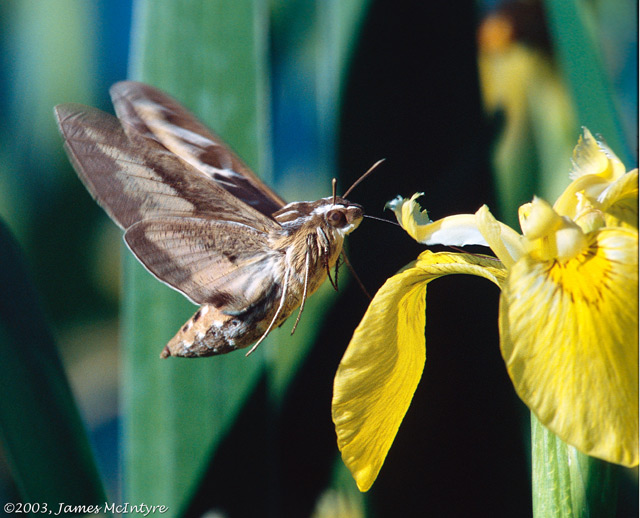This species is not a bird, but it's depicted
in bird guides (e.g. Peterson). It is sometimes mistaken for a
hummingbird. I actually know a photographer who did this. He was most
irate when I questioned his ID and pointed out the facts that hummingbirds
don't have 6 legs, 4 wings or 2 antennae.
Note the long proboscis extending right into the flower! (The beautiful
yellow flowers are escaped domestic "Water Iris", which according to Val
Bachman are becoming commonly established in Utah wetlands.)
I am not a lepidopterist, but I'm reasonably certain the species is
White-lined Sphinx Moth (Hyles lineata). [It's sometimes
nicknamed Hummingbird Moth or Hawk Moth, owing to its hovering, swift
flight pattern]. White-lined Sphinx Moths are among the largest flying
insects of the deserts, with adult wingspans exceeding 5 inches. Larvae
can be just as long, with most having a prominent horn at the rear of
their fleshy body. When alarmed, these larvae rear up their heads in a
threatening sphinx-like posture and may emit a thick, green substance from
their mouths. A sphinx moth caterpillar can actually pull its head back
into its thorax when threatened. For more information, see:
Shot in Weber County, May, 2003. Late one afternoon, I spotted this moth
feeding in a large bed of wild yellow irises and had just prefocused on
this one flower when the moth flew into the picture. It didn't
stay for more than 2 or 3 seconds. I got off one shot (I had no idea
whether it was good at the time) and then it was gone.
According to Greek mythology a sphinx was a female monster having a lion's
body and a human head. It had the habit of asking a riddle and and
killing anyone who failed to answer it. Fortunately this sphinx moth
didn't stay to ask.

